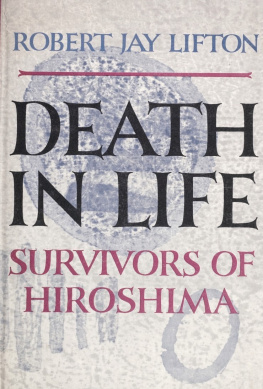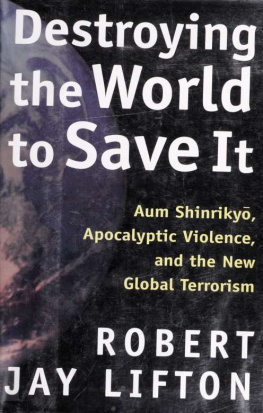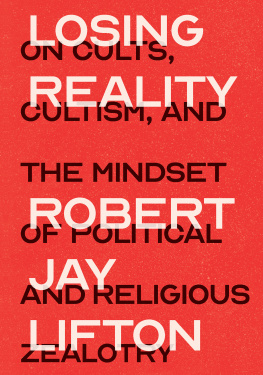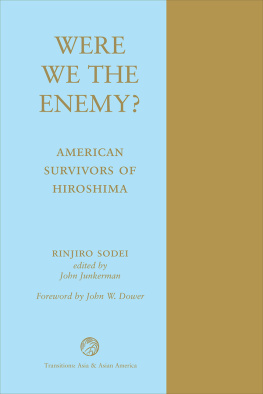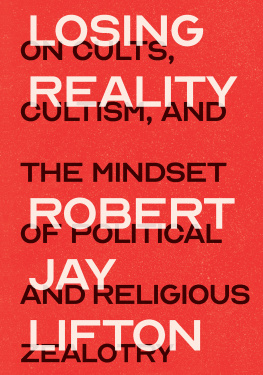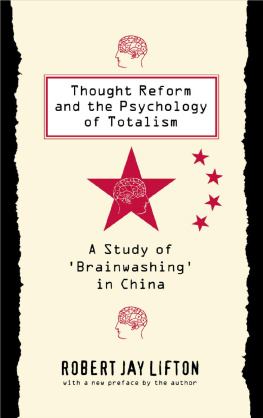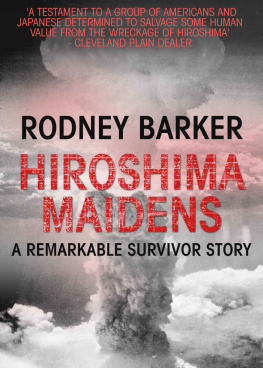Lifton - Death in life · survivors of Hiroshima
Here you can read online Lifton - Death in life · survivors of Hiroshima full text of the book (entire story) in english for free. Download pdf and epub, get meaning, cover and reviews about this ebook. year: 1967, publisher: University of North Carolina Press, genre: Romance novel. Description of the work, (preface) as well as reviews are available. Best literature library LitArk.com created for fans of good reading and offers a wide selection of genres:
Romance novel
Science fiction
Adventure
Detective
Science
History
Home and family
Prose
Art
Politics
Computer
Non-fiction
Religion
Business
Children
Humor
Choose a favorite category and find really read worthwhile books. Enjoy immersion in the world of imagination, feel the emotions of the characters or learn something new for yourself, make an fascinating discovery.
- Book:Death in life · survivors of Hiroshima
- Author:
- Publisher:University of North Carolina Press
- Genre:
- Year:1967
- Rating:5 / 5
- Favourites:Add to favourites
- Your mark:
- 100
- 1
- 2
- 3
- 4
- 5
Death in life · survivors of Hiroshima: summary, description and annotation
We offer to read an annotation, description, summary or preface (depends on what the author of the book "Death in life · survivors of Hiroshima" wrote himself). If you haven't found the necessary information about the book — write in the comments, we will try to find it.
Lifton: author's other books
Who wrote Death in life · survivors of Hiroshima? Find out the surname, the name of the author of the book and a list of all author's works by series.
Death in life · survivors of Hiroshima — read online for free the complete book (whole text) full work
Below is the text of the book, divided by pages. System saving the place of the last page read, allows you to conveniently read the book "Death in life · survivors of Hiroshima" online for free, without having to search again every time where you left off. Put a bookmark, and you can go to the page where you finished reading at any time.
Font size:
Interval:
Bookmark:

Lifton, Robert Jay, 1926
This book was produced in EPUB format by the Internet Archive.
The book pages were scanned and converted to EPUB format automatically. This process relies on optical character recognition, and is somewhat susceptible to errors. The book may not offer the correct reading sequence, and there may be weird characters, non-words, and incorrect guesses at structure. Some page numbers and headers or footers may remain from the scanned page. The process which identifies images might have found stray marks on the page which are not actually images from the book. The hidden page numbering which may be available to your ereader corresponds to the numbered pages in the print edition, but is not an exact match; page numbers will increment at the same rate as the corresponding print edition, but we may have started numbering before the print book's visible page numbers. The Internet Archive is working to improve the scanning process and resulting books, but in the meantime, we hope that this book will be useful to you.
The Internet Archive was founded in 1996 to build an Internet library and to promote universal access to all knowledge. The Archive's purposes include offering permanent access for researchers, historians, scholars, people with disabilities, and the general public to historical collections that exist in digital format. The Internet Archive includes texts, audio, moving images, and software as well as archived web pages, and provides specialized services for information access for the blind and other persons with disabilities.
Created with abbyy2epub (v.1.7.0)
f . /
r

$10.00
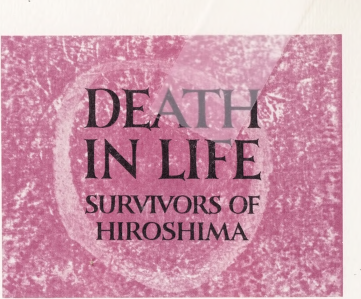
The atomic bombing of Hiroshima in theearly morning of August 6, 1945, is even to-day one of the most debated and disturbingevents in world historv. No one in Hiroshimawas prepared for what happened. For thecity had escaped serious bombing despite itsstrategic wartime significance, and the peo-ples attitudeeven on that morning as theyhurried into the citys center to their jobswas a combination of amazement at its goodfortune and fear that its turn would come.
Robert Jay Lifton, who has lived andworked in Japan for several years, is the firstperson, American or Japanese, to undertakea wide-ranging study of those who survivedthe atomic bombing of Hiroshima. He in-terviewed people in Hiroshima who hadexperienced the bombamong them com-munity leaders, politicians, clergymen, ad-ministrators and directors of survivor andpeace movement groups, medical personnel,scholars, writers, artists, foreigners residentin the city, and visitors to itand quotationsfrom the interviews interwoven with thetaut and coolly analytic narrative provideinsight into survivors struggles and prob-lems: fear of physical afterefi^ is in them-selves or their children, cont i) iiig immer
(cONTINUEb T.,AP)
1/68
jL'h . '-V.- 1>
. K...,> -.....- 'V, -y\!
bsW' -''>' .'''-r'y/




TO.'raaS''.rt
STATE OF VERMONT; DEPARTMENT OF U8RARIESREGIONAL U3RARYRD 2 BOX 244ST. JOHNSBURY, VT 05819
ALSO BY R O B E R 1 JAY L I F T O N
Thought Reform and the Psychology of TotcdismA Study of ''Brainwashing in China
The Woman in America (editor )
DEATH IN LIFE
Survivors of Hiroshima
BY ROBERT JAY LIFTON
To the memory of my father and the world of my children
7^//
CONTENTS
INTRODUCTION: RESEARCH AND
RESEARCHER 3
I HIROSHIMA 13
II THE ATOMIC BOMB EXPERIENCE 13HI INVISIBLE CONTAMINATION 37
IV A - B O M B D I S E A S E 103
V A-BOMB MAN 163
\T ATOMIC BOMB LEADERS 209
yn RESIDUAL STRUGGLES; R U S T , PEACE,AND MASTERY 233
VHI PERCEIVING AMERICA 317
IX FORMULATION: SELF AND WORLD 367
C R E A T I E RESPONSE: 1 ) '
literature/ 397
X
A -BOMB
V 1 1 1
C O N r E N 1 s
XI CREATIVE response: 2 ) ART
DILEMMAS 451
XII T II E S U R V I O R 479
APPENDIX 543NOTES 557INDEX 577
LIST OF SURVIVORS QUOTED
I S T I C
DEATH IN LIFE
Survivors of Hiroshima
INTRODUCTION:RESEARCH AND RESEARCHER
Research is a form of re-creation. I have tried to record the mostimportant psychological consequences of exposure to the atomic bombin Hiroshima. In order to relate the atomic survivor to general hu-man experience, I extended the inquiry to include a wider concept ofthe sur\avor as an entity,highly relevant to our times. These concernsm turn led to a stud\- of death symbolism and the overall impact ofnuclear weapons, which will be published later as a separate volume en-titled The Sense of Innnortality.
Hiroshima stimulates ready resistance within the would-be researcher.It does so partly because of its specific association with massive deathand mutilation, and partly because of the general reluctance of those inthe human sciences to risk professional confrontation with great his-torical events which do not lend themselves to established approaches orcategories. In any case, I have little doubt of my own resistance toHiroshima; I had lived and worked in Japan for a total of more than
four years, over a ten-year period, before I finally visited the cih- in earlvApril of 1962.
At that time I was completing two years of research on Japaneseyouth, as part of a long-standing interest in the interplay betweenindividual psychology and historical change, or in "psvehohistorical
process. In Kyoto, wlierc I was working, I thought only occasionallyabout the worlds first atomic bombed city, which lay about twohundred miles to the southwest. Nor was Hiroshima mentioned par-ticularly frequently by the young men and women, mostly uniyersityundergraduates, whom I was interviewing dailyexcept by those vv'hohappened to haye grown up in its general area. I'he great majority hadeither no memory of the war at all or only the most meager recollectionsof it. But \yhat became clear when I explored with them their sense ofthemselvT'S and their world was the enormous significance for them,hovyeyer indirectly expressed, of the fact that Japan alone had beenexposed to atomic bombs. 'This historical 'fact had much to do withthe power of the peace symbol for all Japanese. It played a veryimportant part in the anti-war sentiment of the mass demonstrations of1960, an extraordinary spectacle which I was able to obserye closelv' andto discuss with militant young participants when they could free them-selvcs for a few moments from their demanding activities on the streets.And it was a matter to contend with eyen in the Reviv^al Boom whiehfollovyedthe reawakened interest in war films, military music, and theliterature of militarv strategy.
These seemingly opposite tendencies can be understood as relatedparts of a general struggle to cope with an unmastered past and athreatening future, a struggle in which Hiroshima faces both ways. T heatomie bombings were experienced, eyen by Japanese born after theytook place, as both an annihilatory culmination of a disastrous period ofhome-grown fascism and militarism, and a sudden infliction of a newand equally unfortunate historical destinya destiny which could,morcoyer, be repeated, and which vyas open to everyone. \\ hat I amsaving is that nuclear weapons left a powerful imprint upon theJapanese which continues to be transmitted, historically and psycho-logically, through the generations. But I could not begin to understandthe eomplexities of this imprint until I embarked upon my work withHiroshima victims thcmsclycs.
Next pageFont size:
Interval:
Bookmark:
Similar books «Death in life · survivors of Hiroshima»
Look at similar books to Death in life · survivors of Hiroshima. We have selected literature similar in name and meaning in the hope of providing readers with more options to find new, interesting, not yet read works.
Discussion, reviews of the book Death in life · survivors of Hiroshima and just readers' own opinions. Leave your comments, write what you think about the work, its meaning or the main characters. Specify what exactly you liked and what you didn't like, and why you think so.

